 |
Expedition Apolobamba - a lot of adventure at a low cost Intention: To go in unsupported (no mules, porters or guides) and climb new peaks in the remote mountain range Cordillera Apolobamba in the Bolivian Andes. Climbers: Olof Dallner & Michael Wåhlin. |
 |
|
Our journey started with research at La Paz guide and climbing agencies. We also met the President of Club Andino Boliviano, Bolivia's Climbing and Skiing Association, Carlos Aguilar. Later on we also met the complete board. We also visited a famous climber in Bolivia, Bernardo Guarachi (climbed Everest, will attempt K2). All of these people were very helpful and we exchanged information about Apolobamba with them. Basically all of them told us it was impossible to do an unsupported expedition in Apolobamba, that is, no porters or mules. Apparently nobody had ever done this. We were though convinced that it was possible and prepared ourselves for an attempt. |
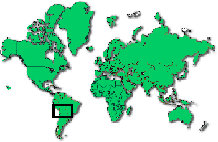 |
 The mountain range Cordillera Apolobamba in the north-west of Bolivia. |
 "Relief data incomplete" . This area looks promising... |
|
The research we had done with different climbing associations indicated that the area west of Cololo near a lake called Lago Paouche would be an area with several unclimbed peaks and that the area was seldom visited by climbers. We decided to take the local bus instead of hiring a transport, all in the spirit of a low budget light-weight expedition. 6 June 2001 We managed to find the local bus that departed from a rather bad neighbourhood in La Paz, so on the day of departure we kept our ice-axes out instead of putting them in our backpacks... The bus to Antaquilla, (a small village in Apolobamba), took 11 hours and stopped only once on the way. We were the only gringos on the bus, the other passengers were natives with animals and huge sacks of vegetables. The bus was rather well used with broken seats and a foul smell. We arrived in Antaquilla after 11 hours, repacked our gear and left the village late in the evening. When we arrived to the first river crossing Olof slipped in the mud but was okay. Thirty seconds later Mike fell into the river and was soaked. We made camp just after the river and the expedition started a bit bad. |
 Olof Dallner on the first day of the walk in to base camp. No mules... |
 Michael Wåhlin on the walk in to base camp. |
|
7 June 2001 We walked 15 kilometres on 4600m with a backpack that weighed 45-50 kilos. It was a very tough day. We passed the pueblo Nubi Pampa and stayed for a while and talked to a native. We camped on the north side of Lago Nubi. That night Olof got diarrhoea and a bad cold. |
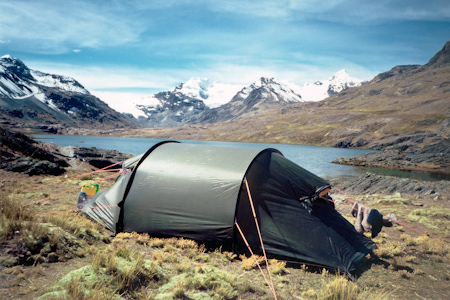 The second camp on the approach. Mountains visible behind the tent: Nevado Jacha Huaracha , Cerro Chualluma and Cololo. |
 Areal view of the approach route to the first base camp. Later on we moved base camp up to 4950m because of too much native attention. |
|
8 June 2001 We arrived at the intended base camp near Lago Paouche after a short but tough day. Olof had problems with getting there. Mike arrived first and erected the tent, Olof arrived a while later and fell asleep on the ground. We had finally established the base camp! |
 Base camp established! It took us 2,5 days of trekking with heavy backpacks to reach the Lago Paouche base camp. The alpacas were everywhere... |
|
9 June 2001 Summit fever. Olof had been sick all night, also Mike was tired and we were vegetating (apparently the word for being knocked out according to Lee and Scott McCook with whom we spent some time with on Huayna Potosi later on). We decided to explore a little around the peaks. During our recon we saw one of the peaks that was unclimbed and decided to climb it. We did this without any problems. It took some time for Olof to summit because he was still quite sick. The first new ascent! |
 The first new peak we climbed was the mountain in the centre of the photo, Cerro Chello Cunka Este (5400m). |
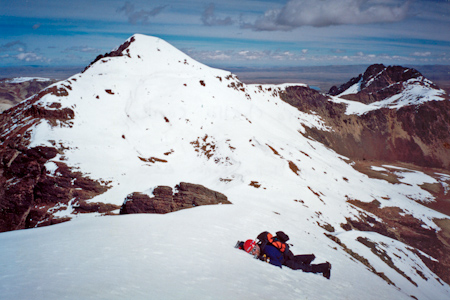 An exhausted and sick Olof Dallner resting on summit ridge of Cerro Chello Cunka Este (5400m). |
 Olof Dallner on summit ridge. |
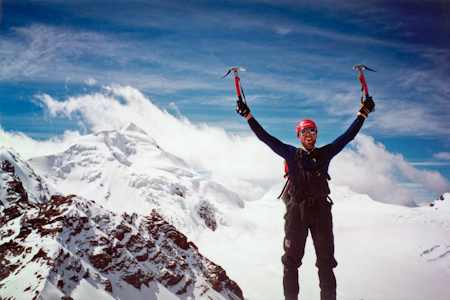 On the top! The peak visible behind Olof Dallner is Cololo. |
 Michael Wåhlin on the top. |
 Swedish Apolobamba! Michael Wåhlin & Olof Dallner. |
We did not bring enough water and slipped into a severe dehydration while returning to base camp. The first new ascent was celebrated with freeze dried Chilli con carne, chocolate mousse and soup (Olof did not manage to keep much of the food).. 10 June 2001 Rest day Mike also got really ill. The day was spent in base camp vegetating. Symptoms of disease was investigated and the conclusion was that Mike probably had amoebic dysentery and Olof some kind of bacterial problem. |
 "Vegetating" in base camp... |
|
11 June 2001 We kept vegetating in BC. The ice-cream box that we had all our medicines in was brought up. Mike took Ciprox (antibiotics) and Metronidazone (poison against amoeba) and Olof took Lexinor (antibiotics). A snow blizzard started while we were vegetating in the tent.
2 June 2001 |
 Nevado Jacha Huaracha (5540m), the highest unclimbed peak in the area. |
13 June 2001 Towards a new summit We woke up at 03:00. Arrived at the glacier at 06:00. We put our crampons and climbing gear on and started walking up the glacier, rather cold. Today we aimed to climb Nevado Jacha Huaracha. We crossed the glacier. There ware few crevasses so we moved quite fast. Arrived below the summit face at 10:00. |
 The summit face of Nevado Jacha Huaracha. (5540m). 200m, 60-75 degrees. |
 Olof Dallner on the north face of Nevado Jacha Huaracha. |
 Michael Wåhlin trying to stay in the shadow as the sun hits the steep summit face of Nevado Jacha Huaracha. The ice/snow quickly turns bad in the heat. (Olof's glove covering the left corner!) |
 Olof Dallner on steep ice high up on the north face of Nevado Jacha Huaracha. |
|
We started to ascend the summit face. It was about 60-75 degrees, ice/snow, 4 pitches (200m). When we reached the summit ridge, Olof stuck his ice axe in and it went through. We could see all the way down the south face in the hole... We arrived at the summit but did not risk stepping up on the highest point a few meters higher, since it was badly corniced. New ascent number two, 5540m. |
 New ascent number two: Nevado Jacha Huaracha 5540m! Olof Dallner (left) and Michael Wåhlin (right). |
It was already 13:00 and the face was starting to get really warm. We descended the ridge and then we were supposed to just drop down to the glacier again. But the sun had melted the ice/snow to slush which is very dangerous and difficult to down climb. We considered staying close to the summit and wait for the sunset and better conditions, but then we decided to try to down climb without the rope (so in case someone slipped he wouldn't drag the other one down) and did so. At 14:00 we had descended the summit face. We were seriously dehydrated and had very little strength left. We staggered down the glacier and then the moraine. At 17:00 we were back in base camp. |
 Descending the glacier looking back towards Nevado Jacha Huaracha summit face. |
|
14 June 2001 Rest day We stayed in base camp and rested. Two Indians came by camp and tried to tell us something, but we did not understand what they wanted to say. But we realized that the Indians had started to get a bit too interested in our base camp, so we decided to move camp the next day. Olof went to recon a way, then we moved half of our gear to the top of a steep slope towards where we wanted the new camp. In that way we would be able to move faster up the slope the next day, and hopefully the Indians wouldn't know where we went. |
 Moving base camp from 4700m to 4950m. Lago Paouche below. Michael Wåhlin (left) and Olof Dallner (right). |
|
15 June 2001 Move Base camp We moved out of base camp in the morning, and the always curious "Pocahontas" was there as usual checking out where we were going. We walked up the steep slope to where we had left some of the gear the day before, and continued up to 4950m just below the Cololo glacier. Base camp 2 seemed a lot more free of llamas, natives and flies. Very comfortable! |
 The new base camp at 4950m, just below the Cololo glacier. |
 We climbed the mountains in the background, from left to right: Cerro Chello Cunka Este (5400m) and Cerro Chello Cunka (5450m) |
|
16 June 2001 Summit day We left base camp aiming for Cerro Chello Cunka (5450m) to make yet another new ascent. This peak is located just next to the first climb we did (Chello Cunka Este) and was a little bit higher. We had no problems to ascend this peak. The only problem was a llama that was a little too interested in Olof but the expedition managed to sneak by. |
 Cerro Chello Cunka (5450m). |
 Michael Wåhlin (left) and Olof Dallner (right) on the summit of Cerro Chello Cunka (5450m). |
 Olof Dallner in a classic alpine pose on the summit! |
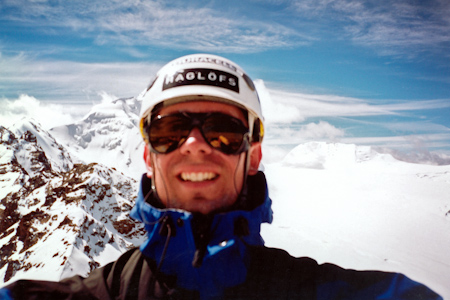 Michael Wåhlin on the summit of Cerro Chello Cunka (5450m). |
|
17 June 2001 Rest day Today was the big day when we changed underwear. This was celebrated with raising the Swedish flag in base camp. We also developed a complicated game of throwing stones, with regulations and scores. Said during the day: There are no stones! (said by two people sitting in a glacial moraine, that is, there was nothing but stones there). We were very picky about which stones was good enough to throw. |
 Changing underwear means flag day in base camp!! |
|
18 June 2001 The Cololo glacier We woke up early and stepped onto the Cololo glacier. We wanted to make a new route on the peak Cololo. Halfway up the glacier we realized that was too soon in the season. We sometimes had snow up to our hips and were moving very slowly. Since the snow was not hard yet we abandoned the attempt and went back to BC for some quality vegetating. |
 Cololo and the Cololo glacier. |
|
19 June 2001 Summit day Since we could not ascend Cololo we ascended the peak closest to base camp, Cerro Chualluma. We reached the south summit, Chualluma south (5390m). New ascent no 4! 20 June 2001 Going Home! We left base camp and started to walk towards Antaquilla. We camped at the same place as on the approach, on the north side of Lago Nubi. We were running out of food and started to discuss and hallucinate all kinds of dishes. We were visited by yet another native that wanted to by our tent, which obviously was not in question. 21 June 2001 We started to walk towards Nubi Pampa on the north side of Lago Nubi. There we met chief no 1 at last, "el Mallku". He explained to us that the demonstrations that was in Bolivia once again had started. No more tranquillity. The syndicate, some kind of union organisation, was unhappy with the government and had put up roadblocks. We had to give "el Mallku" 10 US Dollars so that he would write us a document saying that we were allowed to move in the area without problems. We got the document and left for Antaquilla. We decided to walk almost all the way to Antaquilla but we somehow took the wrong way and walked 5 kilometres longer. A day with 20 kilometres of walking with heavy loads and basically no food. The document written by the Indian Chief: |
 Translation: Nubi Pampa Thursday, June 21st 2001 To whom it may concern in the region of Franz Tamayo. Recommendations to cooperate with the tourists, 2 persons from Sweden, who have spent 2 weeks in The Cordillera Apolobamba climbing mountains, nothing else. Now the persons want to return to La Paz. Please let them pass through the unstable areas in our country. Signed by the Mallku Chief in the Cololo Reservation. |
 Resting on the walk out. Cololo in the background. |
 Michael Wåhlin on the walk out near Antaquilla. |
 Our Hilleberg "Namatj" tent on the Altiplano near Antaquilla. |
22 June 2001 We were camping outside Antaquilla, just vegetating and resting. During the night we saw some lights and hought that someone was sneaking around the tent, so we jumped out with our ice axes ready for combat. But nobody was there. That was probably good cause if there would have been a native there he probably would have had a heart attack. Two gigantic gringos jumping out of the tent with ice axes. 23 June 2001 No food left We woke up and the ground outside was covered with snow and it was cold. We walked towards Antaquilla to take the bus back to La Paz. But when we arrived in Antaquilla we noticed that there were soldiers everywhere. Something was going on. We found out that the bus to La Paz was cancelled because the roads had been blocked. We were trapped in Antaquilla, a village with the population of about 50 people. The soldiers at a check point told us it could take two months before the next bus to La Paz would leave, and they suggested that we try and walk to Peru instead. We managed to take a bus only a couple of kilometres. Then we started to walk with only a pack of crackers and some water, aiming west for Peru... |
 Michael Wåhlin on the long walk towards Peru. The Apolobamba mountains in the background. |
 Olof Dallner near the Peruvian border. |
We walked almost the entire day, crossed a river (the border river) and then finally reached a small village called Cojata. There we managed to buy some pasta that we cooked on our MSR stove in the village plaza while curious Peruvians were gathering around us. From there we got onto a bus to Juliaca. During this bus ride there was an earthquake that has been shown in the news. Apparently 40 people died in Arequipa, not far from where we were. Since the bus ride was bumpy we did not notice the earthquake. Anyway we managed to get to Juliaca, a town pretty close to Lake Titicaca, where we checked in at a hotel and had our first real meal in a long time. |
 The hotel in Juliaca, Peru. |
|
24 June 2001 Early in the morning we went to Puno, a larger town near Titicaca. We heard that there were buses going to La Paz from there. We managed to get onboard a tourist bus that departed for La Paz and we were beginning to really believe that we were going to make it back. Just before Copacabana we arrived at the border between Peru and Bolivia, and it was time for passport check. We left the bus with everybody else and went to the official passport control to leave Peru. When we arrived at the officer he just looked into our passport and shook his head. We had forgot that we were illegally in Peru!!! We had no tourist visas. The bus driver was with us and spoke to the officer. We had filled out the applications for entering Bolivia but the officer just tore them up and told us in Spanish that " officially we had never been to Peru". We stepped out of the office and were then standing in no-mans-land between Bolivia and Peru without being able to go anywhere. The the bus driver waved at us and told us to get back onto the bus and lie down on the floor in the back of the bus. Then he drove through the Bolivian border checkpoint while we were lying in the bus and peeping at the militaries outside. We were illegally smuggled back into Bolivia!!! We paid the bus driver 60 Bolivianos for this (about 10 USD). |
 The escape route into Peru. |
|
In Copacabana we got some lunch and then the bus continued towards La Paz. The road to La Paz was covered with stones that showed there had been trouble in the area. We came to a roadblock with a lot of upset people but we managed to pass it. People were throwing stones at the bus and were generally upset. Finally we managed to get to La Paz!!! Tired and exhausted we checked into our old hotel (they didn't recognize us at first after 3 weeks out in the mountains!) and took a well deserved shower and had a nice meal. |
|
Photos & Text
Copyright © 2001 Michael Wåhlin & Olof Dallner |
|
|
| | K2Kunsult.com |